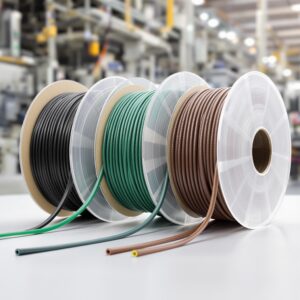FAQ: Teflon® Encapsulated O-Rings: M-Cor Inc.

FEP SILICONE O-RING
International Copyright 2024 © M-Cor Inc, All Rights Reserved
WHAT IS ENCAP-O-SEAL™?
First and foremost, ENCAP-O-SEAL® is the trade name of M-COR, Inc.’s Teflon® encapsulated o-ring. This innovative product represents our commitment to providing high-quality, chemically resistant seals. As a result of its unique properties, ENCAP-O-SEAL® is suitable for a wide range of industrial applications.
WHAT IS A TEFLON® ENCAPSULATED O-RING?
Essentially, a Teflon® encapsulated o-ring is a universal chemical-resistant seal used in industry to prevent the passage of corrosive fluids or gases. Specifically, it consists of two primary components: (1) a Teflon® encapsulation (i.e., jacket or covering) and (2) an elastomer (i.e., rubber) core material. In this design, the Teflon® jacket completely encloses the core. As a result of this combination, the o-ring provides excellent chemical resistance and durability for various industrial applications.
WHAT IS AN ELASTOMER?
Simply put, an elastomer is a general term for elastic, rubber-like substances.

Viton® Extruded Colors
Shelf Life:
Regarding durability, here are the specific shelf life details:
Encapsulation Materials: FEP – Unlimited shelf life PFA – Unlimited shelf life
Elastomers: Viton – 20 years Silicone – 20 years EPDM – 5 to 10 years
WHAT IS THE REASON FOR ENCAPSULATING A RUBBER CORE MATERIAL WITH TEFLON®?
Most importantly, the Teflon® encapsulation, which is virtually chemically inert, allows the o-ring to resist nearly all chemicals, thereby extending seal life and preventing contamination. Additionally, the elastomer core material imparts its mechanical properties to the o-ring. Unlike solid TFE o-rings, Teflon® encapsulated o-rings effectively resist cold flow. As a result of this synergy, Teflon® encapsulated o-rings gain their unique properties: chemical resistance, anti-stick qualities, resilience, and resistance to cold flow.
WHAT TYPES OF TEFLON® ARE USED TO ENCAPSULATE THE RUBBER CORE MATERIAL?
In our commitment to quality, M-COR, INC. uses only the highest quality certified virgin Teflon® resins: FEP and PFA. Through the selection of these premium resins, we ensure that our Teflon® encapsulated o-rings meet the stringent requirements of various industrial applications. Moreover, the use of certified virgin resins guarantees consistent performance and reliability.
WHAT IS TEFLON® FEP?
In technical terms, Teflon® FEP fluorocarbon resin a melt-processible copolymer of Tetrafluoroethylene and Hexafluoropropylene. Not only is it practically chemically inert, but it also has an operating temperature of 205°C (400°F) and possesses the highest molecular weight of the FEP family of resins. Notably, it withstands chemical attack at elevated temperatures. Since its invention by DuPont in 1960, engineers have specified Teflon® FEP encapsulation for corrosive-resistant seals with operating temperatures up to 205°C (400°F).

Teflon® Ecxtrusion
WHAT IS TEFLON® PFA?
Similarly, Teflon® PFA fluorocarbon resin is a melt-processible copolymer of Tetrafluoroethylene and Perfluorinated vinyl ether from the Perfluoroalkoxy group. Like FEP, it is practically chemically inert; however, it has a higher operating temperature of 260°C (500°F) and maintains one of the highest molecular weights of the PFA family of resins. As a result, Teflon® PFA effectively withstands chemical attack at elevated temperatures. Following its invention by DuPont in the 1970s, engineers have consistently specified Teflon® PFA encapsulation for corrosive-resistant seals with operating temperatures up to 260°C (500°F).
WHAT TYPES OF ELASTOMER (RUBBER) CORE MATERIAL ARE USED IN M-COR’S TEFLON® ENCAPSULATED O-RING?
To ensure the highest quality, we use specially formulated, high-temperature FDA-compliant, and USP Class VI Compliant elastomers. These include both solid core and hollow core Dow Corning® silicone, as well as Chemours solid core or hollow core Viton®. Furthermore, EPDM is available upon request, along with Viton FDA Compliant material. Through this diverse selection, we ensure that our elastomers meet varied application needs and stringent regulatory standards.
WHAT ARE THE ADVANTAGES OF USING A VITON® ENCAPSULATED O-RING RATHER THAN A SILICONE ENCAPSULATED O-RING?
When considering applications involving a wide temperature range in diverse chemical service, a Viton® core is typically the better choice. This is because chemical permeation can compromise the core material in some cases. Moreover, Viton® offers a greater range of chemical compatibility than silicone core and may therefore extend seal life. *See Gas Permeability for additional details.
WHAT IS A HOLLOW CORE O-RING AND WHY IS IT USED?
To understand hollow core o-rings, it’s important to note that ENCAP-O-SEAL® hollow core o-rings consist of two key components: (1) a Teflon® encapsulation (i.e., jacket or covering) and (2) an elastomer (rubber) hollow core material, which is completely enclosed within the Teflon® encapsulation. By encapsulating hollow-core o-rings, M-COR, INC. creates a softer durometer seal, thereby reducing the amount of clamping force needed. Specifically, the durometer of our standard hollow core ENCAP-O-SEAL® o-ring decreases by approximately 10%. Additionally, M-COR, INC. can design special core configurations to meet specific durometer requirements. Consequently, engineers often specify ENCAP-O-SEAL® hollow core o-rings in applications where clamping force must be minimized due to other mechanical design considerations, such as ID/OD static or dynamic cylinder o-ring glands, hand-tightened lids, caps, and similar applications.
Is the ENCAP-O-SEAL Teflon Encapsulated O-Ring FDA and USP VI compliant?
Yes, all materials of manufacture are fully compliant with these regulations.
WHAT IS DUROMETER?
In simple terms, durometer is a numerical scale for measuring the hardness of rubber.
What is the Durometer of the Teflon® Encapsulation?
The Teflon® encapsulation has a durometer of 55 Shore D.
WHAT ARE THE DUROMETERS OF ENCAP-O-SEAL® O-RINGS?
Our products feature the following durometer specifications:
ENCAP-O-SEAL® solid silicone core: 85-90 Shore A ENCAP-O-SEAL® solid Viton® core: 90-95 Shore A ENCAP-O-SEAL® hollow core silicone: 70-80 Shore A
WHAT IS HARDNESS SHORE A?
To clarify, Hardness Shore A is the durometer reading in degrees of the hardness of rubber. For reference, a Shore A hardness of 35 is considered soft, while 90 is considered hard. Understanding these readings is therefore essential for selecting the appropriate rubber material for specific applications.
DO TEFLON® ENCAPSULATED O-RINGS MEET AS568 STANDARDS?
While all Teflon® encapsulated o-rings are manufactured to meet AS 568 standards as closely as possible, it’s important to note that they have greater cross-sectional and inside diameter tolerance ranges than AS 568 standards. Because Teflon® encapsulated o-rings are not necessarily molded products, all inside diameter tolerances conform to those for straight-length, unspliced extrusions. In maintaining quality standards, M-COR, INC. adheres to the highest precision standards published in the RMA HANDBOOK (Rubber Manufacturers Association).
WHAT QUALITY CONTROL STANDARDS OR INSPECTION CRITERIA DO YOU USE?
Given the critical sealing applications of ENCAP-O-SEAL® Teflon® encapsulated o-rings, we maintain strict quality control standards. First, cross-sectional and inside diameter dimensions must meet the criteria set forth in the Tolerance Chart section of our Quality Manual. Additionally, using the RMA handbook as an o-ring inspection guide for surface imperfections control, M-COR, INC. has developed a comprehensive quality control manual. This manual establishes quantitative levels of acceptance for ENCAP-O-SEAL® Teflon® encapsulated o-rings relative to imperfection type, size, and quantity (*See Quality Assurance Blog). Through these rigorous standards, we ensure our products meet the highest levels of quality and reliability.
WHAT IS THE RMA HANDBOOK?
The RMA Handbook, carefully researched and published by the Technical Committee of the Rubber Manufacturers Association, serves as a comprehensive guide describing visual quality acceptance criteria for o-rings. As a cooperative manufacturing trade association, the RMA provides essential guidelines for ensuring the quality and reliability of o-rings across various applications.
WHAT IS COLD FLOW?
In materials science, cold flow refers to continued deformation under stress. Understanding this property is crucial for the design and application of seals, as it helps engineers select appropriate materials that can withstand prolonged stress without significant deformation.
WHAT IS COMPRESSION SET?
In technical terms, compression set describes the decrease in thickness of a rubber specimen that has been deformed under specific conditions of load, time, and temperature. This property is particularly important for ensuring the durability and effectiveness of rubber seals in various applications. For more detailed information, please refer to the Compression Set Blog.
WHAT IS A COPOLYMER?
From a chemical perspective, a copolymer is a polymer consisting of two different monomers chemically combined. Through this combination, unique properties emerge that can be tailored for specific applications. Understanding the structure of copolymers is therefore essential for selecting the right materials in various industrial processes.
[Additional Technical Terms and Definitions:]
Each of the following terms plays a vital role in understanding o-ring technology and applications:
CROSS-SECTION: This refers to an o-ring as viewed if cut at right angles to the axis, enabling detailed examination of the o-ring’s internal structure.
CURING DATE: This important date marks when the manufacturing process is complete and the o-ring is ready for shipment.
STATIC APPLICATION: Simply put, this refers to a stationary application.
STATIC SEAL: This type of seal works between parts having no relative motion.
DYNAMIC APPLICATION: In contrast to static applications, this refers to situations where the o-ring is subject to movement or moving parts.
DYNAMIC SEAL: This specialized seal prevents leakage past parts that are in relative motion.
EXTRUSION: This term describes distortion under pressure that forces the seal into the clearance between mating metal parts.
GLAND: This refers to a seal assembly groove, including the o-ring, the groove, and the mating/sealing surfaces.
HOMOGENEOUS: This describes a material with uniform composition throughout.
PERMANENT SET: This term refers to the deformation remaining after a specimen has been stressed in tension for a prescribed time and then released for a definite period.
PERMEABILITY: This important property describes the ability of gas to pass through the molecular structure of rubber, plastic, or other materials.
POLYMER: From a chemical standpoint, this forms by joining together many (poly) individual units (mer) of a monomer.
RESILIENCE: This crucial property refers to the ability to return to an original size and shape after deformation.
RMS: Standing for Root Mean Square, this measures surface roughness, calculated as the square root of the sum of the squares of micro-inch deviations from true flatness.
ACTUAL SIZE: This refers to the precise dimensions of the o-ring, including tolerance limits.
NOMINAL SIZE: In contrast to actual size, this describes the approximate size of the o-ring in fractional dimensions.
SPECIFIC GRAVITY: This property is defined as the ratio of the weight of a given substance to the weight of an equal volume of water at a specified temperature.
SQUEEZE: In technical terms, this describes the cross-section diameter compression of an o-ring between the bottom surface of the groove and the surface of other mating metal parts in the gland assembly.
STRESS: This refers to the force per unit of the original cross-sectional area required to stretch a specimen to a stated elongation.
O-RING SWELL: This phenomenon describes the increased volume of an o-ring caused by immersion in fluids.
TENSILE STRENGTH: Finally, this property measures the force in pounds per square inch required to rupture a specimen of rubber material.
For more detailed information, please visit our Blog
International Copyright 2024 © M-Cor Inc, All Rights Reserved
